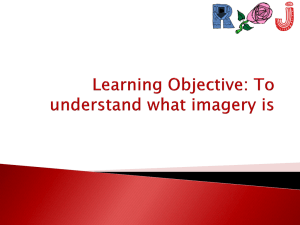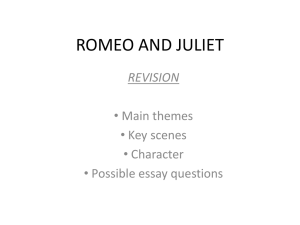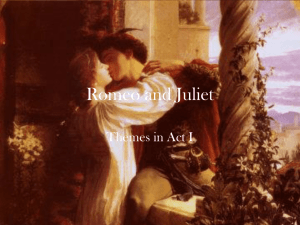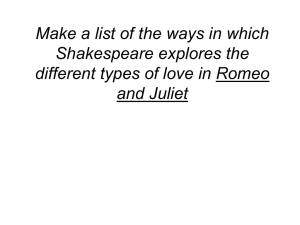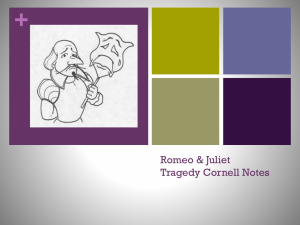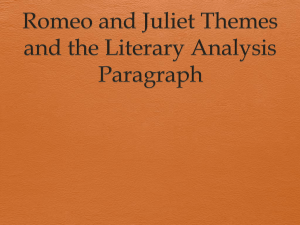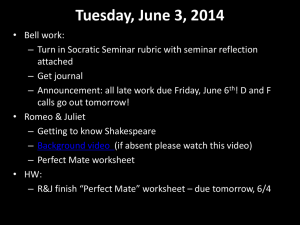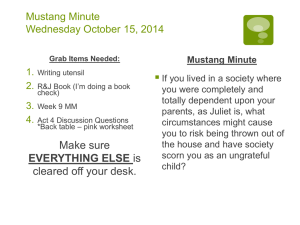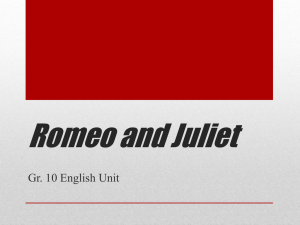Literary Devices - Buena Park High School
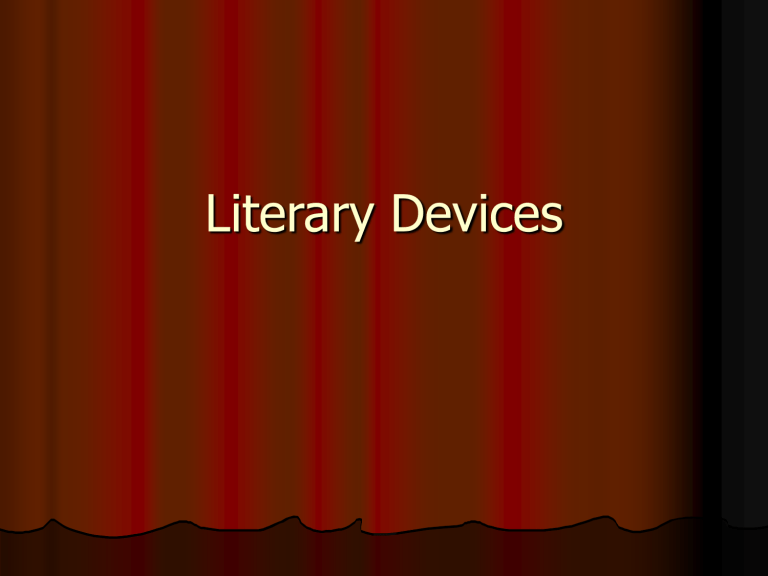
Literary Devices
Allusion
Definition: a reference to a well known person, place, event, literary work, or work of art.
Example: Mercutio references Queen Mab.
“ O, then I see Queen Mab hath been with you”
Act I, scene iv, line 53
Analogy
Definition: makes a comparison between two things that are similar in some way but otherwise unalike.
Example: Juliet uses an analogy to explain the silliness of hating someone because their name is Montague: “What’s in a name? That which we call a rose/ By any other name would smell as sweet” (Act 2, scene 2, lines
43-44).
Antagonist
Definition: a character or force in conflict with the main character.
Example: Tybalt is an antagonist against
Romeo.
“I will withdraw; but this intrusion shall/ convert to bitt’rest gall”
Act I, scene 5, lines 90-91
Aside
Definiton: a short speech delivered by an actor directed toward the audience not the characters on stage.
Example: Romeo tells the audience his thoughts: “Shall I hear more, or shall I speak at this?” (Act 2, scene 2, line 37).
Blank Verse
Definition: poetry written in unrhymed iambic pentameter lines
Example: Most of Romeo and Juliet is written in blank verse.
Characterization
Definiton: The act of creating and developing a character
Example: Tybalt is a flat/static character who is pugnacious and angry.
Climax
Definition: the high point of interest or suspense.
Example: When Romeo takes poison and
Juliet stabs herself.
Conflict
Definition: a struggle between opposing forces.
Example: Paris tries to arrest Romeo in the tomb: “Stop thy unhallowed toil, vile
Montague” (Act 5, Scene 3, line 54).
Couplet
Definition: a pair of rhyming lines of the same length and meter.
Example:
“The which if you with patient ears attend,/
What here shall miss, our toil shall strive to mend.”
Act I, Prologue, Lines 13-14
Diction
Definition: the words the author chooses to use (formal, informal, etc.)
Example: Shakespeare uses an eloquent style that contributes to the romance and tragedy of the play.
Dramatic Irony
Definition: The audience knows information that the characters do not know
Example: Romeo tells Juliet when he thinks she is dead that “death’s pale flag is” not on her face
(Act V, Scene v, line 96). What we know that
Romeo does not is Juliet is not dead that is why her face doesn’t look so.
Epithet
Definition: a characterizing word or phrase accompanying or occurring in place of the name of a person or thing
Example:
star-crossed lovers = Romeo & Juliet
Figurative Language
Definition: writing or speech not meant to be interpreted literally.
Example: “…now thou art so low, / As one dead in the bottom of a tomb” (Act 3, Scene
5, lines 55-56).
Foil
Definition: A character foil is a character whose traits are opposite to the protagonist.
Example: Tybalt is Romeo’s character foil.
Foreshadowing
Definition: clues that suggest events that occur later in the story.
Example: “I fear, too early; for my mind misgives…By some vile forfeit of untimely death” (Act I, Scene iv, lines 106 & 111).
Iambic Pentameter
Definition: is a commonly used metrical line in traditional verse; it describes the particular rhythm that the words establish in that line.
Example: Shakespeare wrote many lines in
Romeo and Juliet using iambic pentameter, the balcony scene is one example.
Imagery
Definition: the creation of word pictures for the reader to imagine
Example: “It is some meteor that the sun exhales/ To be to thee this night a torchbearer/ And light thee on thy way to
Mantua” (Act 3, Scene 5, lines 13-15).
Metaphor
Definition: comparing two unlike things. The analogy is implied, not stated.
Example: The Friar compares Romeo to and ill-beseeming beast because he looks like a man, but he is acting like a woman.
Motivation
Definition: a reason that explains or partially explains why a character thinks, feels, acts, or behaves in a certain way.
Example: The Friar agrees to marry Romeo and Juliet because he wants the two households to get along: “For this alliance may so happy prove/ To turn your households’ rancor to pure love” (Act 2, scene
3, lines 91-92).
Protagonist
Definition: the main character
Example: Romeo and Juliet
Pun
Definition: – a humorous play on words that is similar in sound but different in meaning
Example:
Mercutio: That dreamers often lie.
Romeo: In bed asleep…
Act I, scene v, line 52
Repetition
Definition: the use of any element of language – a sound, a word, a phrase, a clause, or a sentence – more than once.
Example: Mercutio repeats the phrase “A plague on both your houses” (Act 3, scene
1, lines 94 & 100).
Monologue
Definition: A speech by one character in a play.
Example: Prince Escalus’ speech banning the fighting between the Montagues and
Capulets. (Act I, scene 1, lines 72-94).
Oxymoron
Definition: An oxymoron are contradictory or opposite words together.
Example:
Feather of lead, bright smoke, cold fire, sick health, Still-waking sleep, that is not what it is!
Romeo, lines 171-2
Personification
Definition: a nonhuman subject is given human characteristics.
Example: Capulet explains how he feels about his daughter’s death: “Death, that hath taken her …ties up my tongue and will not let me speak” (Act 4, scene 5, lines 31-32)
Simile
Definition: Comparing two unlike things using the words like or as
Example: The Friar explains to Romeo why he should slow down with his love for Juliet:
“These violent delights have violent ends/
And in their triumph die, like fire and powder” (Act 2, Scene 6, lines 9-10).
Situational Irony
Definition:
Something happens that you/characters don’t expect.
Example: Romeo is a romantic; he doesn’t like fighting, he ends up killing Tybalt.
Soliloquy
Definition: a long speech expressing the thoughts of a character alone on stage.
Example: The speech when Juliet is waiting for Romeo to return to her for their wedding night. (Act 3, scene 2, lines
1-34).
Sonnet
Definition: a 14 line lyric poem, usually written in iambic pentameter
Example: the Prologue is a 14 line poem in iambic pentameter
Symbol
Definition: anything that stands for or represents something else.
Example:
The mask symbolizes secrecy and the ability to act not as yourself.
That I have worn a visor and could tell
A whispering tale in a fair lady’s ear,
Capulet, Act I, scene v, lines 20-22
Suspense
Definition: a feeling of uncertainty about the outcome of events in a literary work.
Example: When Friar John tells Friar
Lawrence that the letter to Romeo in
Mantua never got delivered:
Friar: “Bare my letter then to Romeo?”
John: “I could not send it – here it is again –”
Act 5, scene 2, lines 13-14
Theme
Definition: a central message or insight into life revealed through a literary work.
Example:
Young Love: Love without the knowledge and careful planning of adulthood.
Romeo is making arrangements to marry Juliet within 24 hours of meeting her.
Verbal Irony
Definition:
Saying one thing but meaning another
Example: Mercutio is looking for Romeo after the Capulet party and he calls to him, “The ape is dead, and I must conjure him./I must conjure thee by Rosaline’s bright eyes.”
